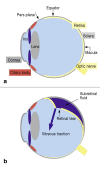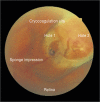Rhegmatogenous retinal detachment--an ophthalmologic emergency
- PMID: 24565273
- PMCID: PMC3948016
- DOI: 10.3238/arztebl.2014.0012
Rhegmatogenous retinal detachment--an ophthalmologic emergency
Abstract
Background: Rhegmatogenous retinal detachment is the most common retinological emergency threatening vision, with an incidence of 1 in 10 000 persons per year, corresponding to about 8000 new cases in Germany annually. Without treatment, blindness in the affected eye may result.
Method: Selective review of the literature.
Results: Rhegmatogenous retinal detachment typically presents with the perception of light flashes, floaters, or a "dark curtain." In most cases, the retinal tear is a consequence of degeneration of the vitreous body. Epidemiologic studies have identified myopia and prior cataract surgery as the main risk factors. Persons in the sixth and seventh decades of life are most commonly affected. Rhegmatogenous retinal detachment is an emergency, and all patients should be seen by an ophthalmologist on the same day that symptoms arise. The treatment consists of scleral buckle, removal of the vitreous body (vitrectomy), or a combination of the two. Anatomical success rates are in the range of 85% to 90%. Vitrectomy is followed by lens opacification in more than 70% of cases. The earlier the patient is seen by an ophthalmologist, the greater the chance that the macula is still attached, so that visual acuity can be preserved.
Conclusion: Rhegmatogenous retinal detachment is among the main emergency indications in ophthalmology. In all such cases, an ophthalmologist must be consulted at once.
Figures







References
-
- Mitry D, Fleck BW, Wright AF, Campbell H, Charteris DG. Pathogenesis of rhegmatogenous retinal detachment: predisposing anatomy and cell biology. Retina. 2010;30:1561–1572. - PubMed
-
- Mitry D, Charteris DG, Fleck BW, Campbell H, Singh J. The epidemiology of rhegmatogenous retinal detachment: geographical variation and clinical associations. Br J Ophthalmol. 2010;94:678–684. - PubMed
-
- Mitry D, Singh J, Yorston D, Siddiqui MAR, Wright A, Fleck BW, et al. The predisposing pathology and clinical characteristics in the Scottish retinal detachment study. Ophthalmology. 2011;118:1429–1434. - PubMed
-
- Morgan IG, Ohno-Matsui K, Saw SM. Myopia. Lancet. 2012;379:1739–1748. - PubMed
-
- Feltgen N, Weiss C, Wolf S, Ottenberg D, Heimann H. Scleral buckling versus primary vitrectomy in rhegmatogenous retinal detachment study (SPR Study): recruitment list evaluation Study report no. 2. Graefes Arch Clin Exp Ophthalmol. 2007;245:803–809. - PubMed
Publication types
MeSH terms
Supplementary concepts
LinkOut - more resources
Full Text Sources
Other Literature Sources
Medical

